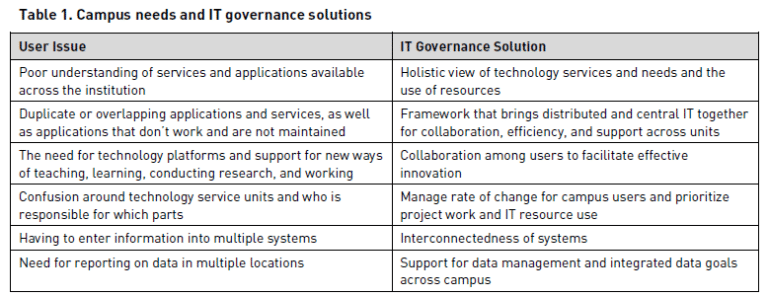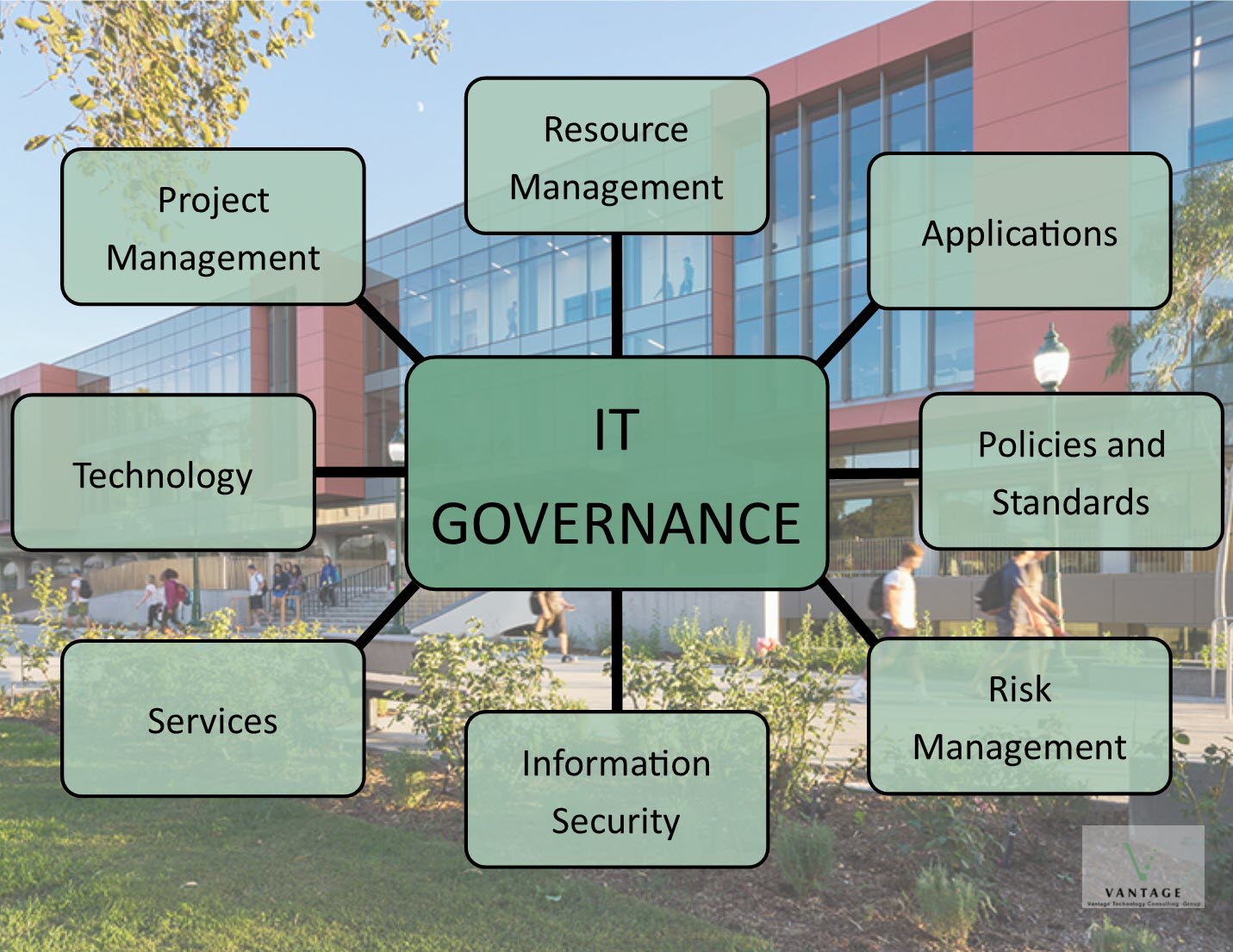This is Part 1 of the IT Governance for Higher Education series of blog posts, based on the IT Governance Toolkit developed by Vantage Senior Consultant Cathy Bates for EDUCAUSE.
What is IT Governance?
Information Technology (IT) is the glue behind almost every system and process at our universities and colleges, but how should it be governed to maximize efficiency and effectiveness? That’s the million-dollar question and it is why the concept of IT Governance is so important in higher education. Simply defined, IT Governance is the strategic, operational, and technical processes that ensure the effective and efficient use of IT in supporting and enabling an organization to achieve its strategies and objectives.
IT Governance covers everything related to technology including:
- All technology, applications and services used by the organization
- IT resource management – allocating personnel and financial resources to support technology services
- IT project management – balancing technology investments with needs, strategy and budget
- Information security – protecting information and technology
- IT policies and standards – the responsibility and rules for using technology
- IT risk management – mitigating technology risks and supporting compliance
Why is IT Governance Needed?
The typical college or university maintains a diverse technology landscape that has grown organically over time and often contains various technology silos throughout the institution. Many applications and services might be in use across the institution, sometimes several with similar or even identical functionality, certainly many with overlapping functionality. When an application fails to meet user needs, the cure is often to purchase a different solution, hoping for a different outcome resulting in overlapping applications that are difficult to efficiently manage or track. Because these applications may not be supported or integrated, many processes still involve manual and redundant steps to bridge data across applications, leading to further inefficiencies and inaccuracies.
When technology decisions are made at the departmental level without cross-divisional or cross-institutional collaboration the following issues can arise:
- Poor understanding of available applications and services
- Duplicate or overlapping applications and services
- Little or no technology support for some applications and services
- Little or no integration among applications and services
- Confusion around who is responsible for which technology or systems
- Difficulty reporting on data or budgets across multiple locations
Despite these challenges, many institutions have made substantial progress through the efforts of talented technologists. Most institutions have a central technology unit that provides core technology services across the campus. Some institutions also deliver technology through distributed technology units, such as student affairs, learning technology services, library services, financial services and individual colleges or departments. The bottom line is that significant technology gaps and deficiencies still exist due to lack of coordination, management and oversight in technology investments.
How Can IT Governance Solve the Issues?
A framework and process is critical for governing higher education’s technology today, and those solutions fall under the IT Governance umbrella.
The following table from the IT Governance Toolkit identifies how different IT governance solutions can address some of the common needs facing most campuses:

Table-1-from-EDUCAUSE-IT-Governance-Toolkit-768×296
While solutions are based on principles, common sense and thoughtful management, implementing an IT Governance program is not as simple as it seems. There are many moving parts to consider when creating a successful IT Governance program and getting a handle on all the applications and services in use is just a start.
Other considerations include:
- Creating a framework that includes all vested parties
- Defining the organization’s IT strategy, goals and priorities
- Developing policies to manage IT and technology acquisition, usage and risk
- Creating repeatable processes for governing all IT resource decisions
- Detecting integration points between applications and departments, and
- Identifying how technologies can be leveraged for greater innovation and collaboration among faculty, students and staff.
Over the next several weeks, we will publish additional blog posts on other aspects of developing and delivering an IT Governance program.
Cathy Bates, a Senior Consultant with Vantage Technology Consulting Group, has over 30 years’ experience in higher education focused on strategic planning, information security and IT governance. The IT Governance series of blog posts is based on the IT Governance Toolkit that Cathy developed for EDUCAUSE.
- Part 2 – How Should IT Governance for Higher Education Be Organized?
- Part 3 – Give Focus and Meaningful Work to Your IT Governance Groups
- Part 4 – Developing and Implementing IT Governance for Higher Education



